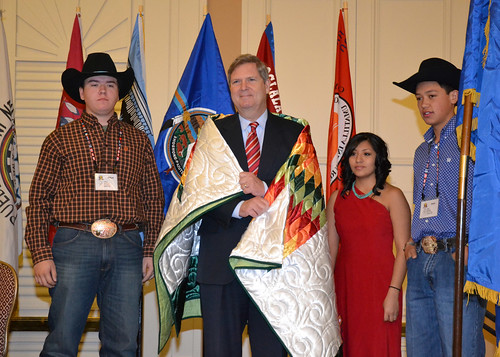
USDA celebrates National Native American Heritage Month in November with a blog series focused on USDA’s support of Tribal Nations and highlighting a number of our efforts throughout Indian Country and Alaska. Follow along on the USDA blog.
Earlier today, I met with leaders from the 566 federally-recognized Native nations who participated in the White House Tribal Nations Conference. This was the seventh of such conferences hosted by the Obama Administration, and built upon the President’s commitment to strengthen the government-to-government relationship with Indian Country and to improve the lives of American Indians and Alaska Natives, with an emphasis on increasing opportunity for Native youth.
All told, over the course of the Administration, the U.S. Department of Agriculture alone has invested nearly $3 billion in rural development projects that have helped Tribal members achieve the dream of homeownership; improved community facilities in Tribal communities; made critical upgrades to electric, water and telecommunications infrastructure that serve Tribal communities and members; and invested in the Tribal businesses and entrepreneurs who drive economic growth in Indian Country.
My conversation with Tribal leaders focused on three key areas: how public and private partners can drive infrastructure investment in Indian Country; how to expand access to capital for Tribal-owned businesses to spur economic growth in Indian Country; and how to strengthen services and programming for Tribal youth. An overarching theme of the conversation was how we can sustain and establish permanency for the good work done in partnership with Tribal leaders over the past seven years, as we move into the final year of the Administration.
Investments in strong, secure infrastructure in Indian Country—things like roads and bridges, but also internet access, housing and community facilities like hospitals and schools—help to improve connectivity and access to information, move products to market, and make communities competitive and attractive to businesses and investments. One of the ways we work to secure investment in these types of projects is through the Obama Administration’s place-based initiatives, exemplified by the Tribal Promise Zones and USDA’s StrikeForce for Rural Growth and Opportunity, which work with American Indian and Alaska Native communities across the country. Just this week, USDA announced an investment of $3.9 million to build and improve water and wastewater infrastructure, including one award for the Red Lake Band of Chippewa Indians in Minnesota and five awards in California, including Big Sandy Rancheria, two awards to the Cortina Band of Wintun Indians, the Grindstone Indian Rancheria, and the Yurok Tribe.
Upgraded facilities in particular can help to improve the quality of life in Tribal communities and provide state-of-the-art healthcare, education and training, particularly for young people. One of the most important things we can do for any child, no matter where they’re born and raised, is to ensure that they have access to a high quality education and USDA has the resources to help. For example, USDA worked with Red Cloud Indian School in Pine Ridge, South Dakota to update the substandard furniture students, faculty and staff used every day. USDA employees in South Dakota helped the school apply for a grant through the Economic Impact Initiative Grant Program, and Red Cloud Indian School was able to purchase new tables, desks and projectors. And earlier this year, Education Secretary Arne Duncan and I met with leadership from Native American LifeLines, an organization that serves Native American families in east Baltimore. During the meeting, we explored ways to better serve urban Native communities, including using urban agriculture as an opportunity to reconnect Native youth to the land and teach important lessons about healthy eating.
And to support higher education opportunities in Tribal communities, today, USDA announced nearly $2 million in grants to support research projects in American Indian communities through the Tribal College Research Grants Program, made possible by the 2014 Farm Bill. This funding builds on more than $115 million invested in Tribal post-secondary institutions by USDA over the past seven years. Projects from this year include research by Tohono O’odham Community College into new practices for food-seed storage and hospitable living in areas of extreme heat and drought through modernizing and increasing the energy efficiency of ancient architectural practices. Another project from Diné College will work on the most efficient way to propagate seeds of yucca species and identifying plants from five yucca species that exhibit superior qualities as food and fiber crops.
These are just a few examples of the myriad ways USDA works with Tribes. As 2015 comes to a close, we will continue to work with Tribes on a government-to-government basis, consulting and collaborating with them, and striving to ensure that they receive their fair share of support from USDA programs—support that not only provides jobs and educational opportunities, but also honors our promises and treaty responsibilities. Whether you are a Tribe interested in a wide variety of construction and business possibilities or a Tribal citizen interested in establishing or expanding your farm, ranch or small business, I encourage you to work with our Office of Tribal Relations to get a broad spectrum perspective on the resources available through USDA.

